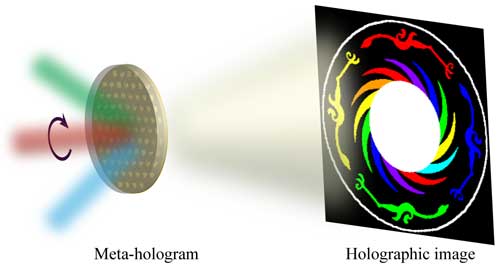| Posted: Nov 09, 2016 | |
Full-color 3D meta-holography with a single nanostructured layer |
|
| (Nanowerk Spotlight) Holography is an important branch of optics which designs and reconstructs electromagnetic waves with the whole information of light, i.e., phase and amplitude. This technique enables a light field – the product of laser light scattered off objects – to be recorded and later reconstructed when the original light field is no longer present, due to the absence of the original objects. Holography can be thought of as somewhat similar to sound recording, whereby a sound field created by vibrating matter like musical instruments or vocal cords, is encoded in such a way that it can be reproduced later, without the presence of the original vibrating matter. | |
| Holograms already are a ubiquitous part of our lives. They are in our wallets – protecting credit cards, bank notes and passports from fraud – in grocery store scanners and biomedical devices. However, the realization of a matrix-free, full-color 3D display for the naked eye is still some way off. | |
| The principle of holography has greatly expanded visualization possibilities, in particular through the widespread use of computer-generated holograms. The large pixel size and the limited phase modulation ability of the traditional computer-generated holograms, however, usually restrict the performance of holography applications, e.g., the limited viewing angle and the 3D full-color imaging ability. | |
| A research team, led by Prof. Xiangang Luo from the State Key Laboratory of Optical Technologies on Nano-fabrication and Micro-engineering (SKLOTNM), Institute of Optics and Electronics, Chinese Academy of Sciences, and Prof. Minghui Hong's team from Department of Electrical and Computer Engineering, National University of Singapore, have now demonstrated that full-color 3D meta-holography imaging with extended viewing angles can be realized by a single layer of nanostructured metallic surface. | |
| The researchers have published their findings in the November 4, 2016 online edition of Science Advances ("Multicolor 3D meta-holography by broadband plasmonic modulation"). | |
 |
|
| An illustration of full-color meta-holography. (Image: SKLOTNM, Chinese Academy of Science) | |
| "We have demonstrated full-color 3D meta-holography imaging by a meta-hologram which is constructed using the electron beam lithography (EBL) to fabricate nano-slit antenna arrays, i.e. nano-rectangular holes, in a 75-nm-thick chromium film," Xiong Li, a researcher at SKLOTNM and the paper's first author, tells Nanowerk. | |
| He notes that the phase modulation within the entire visible color range is fully controlled by spatially adjusting the orientation angle of the nano-rectangular holes, due to the intrinsic achromatic feature of the structure. | |
| The minimum pixel size of the hologram is only 200×200 nm2, which is much smaller than the wavelength of visible light. So the viewing angle of the holographic projection can be larger than ± 90 degrees, i.e., imaging in whole half space. | |
| "In order to overcome the cross-talk among different colors that normally exists in current metasurface holography, we introduced an off-axis illumination method to shift the holographic image in different colors and successfully reconstructed all visible colors in the imaging area," explains Li. | |
| To illustrate their reconstructed holographic 3D multicolor object, the team made a 3D spiral helix pattern composed of twenty point sources with different color. At different positions along the transmission axis, the holographic image is captured by a CCD camera. Stars with varying colors can be identified clearly in these images. (Video: SKLOTNM, Chinese Academy of Science) | |
| Taking advantages of the achromatic feature of the structure, the team also demonstrated full-color holography based on seven primary colors and 3D holographic imaging. | |
| The scientists conclude that their novel approach offers new routes for many exciting applications, such as the angle-tuned dynamic meta-hologram and matrix-free 3D display for the naked eye. Various fields, including data storage, security, and authentication, can also benefit from this technique. | |
 By
Michael
Berger
– Michael is author of three books by the Royal Society of Chemistry:
Nano-Society: Pushing the Boundaries of Technology,
Nanotechnology: The Future is Tiny, and
Nanoengineering: The Skills and Tools Making Technology Invisible
Copyright ©
Nanowerk LLC
By
Michael
Berger
– Michael is author of three books by the Royal Society of Chemistry:
Nano-Society: Pushing the Boundaries of Technology,
Nanotechnology: The Future is Tiny, and
Nanoengineering: The Skills and Tools Making Technology Invisible
Copyright ©
Nanowerk LLC
|
|
|
Become a Spotlight guest author! Join our large and growing group of guest contributors. Have you just published a scientific paper or have other exciting developments to share with the nanotechnology community? Here is how to publish on nanowerk.com. |
|
